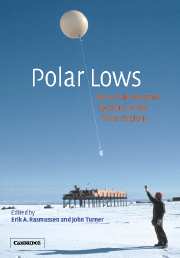Preface
Published online by Cambridge University Press: 07 December 2009
Summary
Since the first detailed investigations of polar lows and other high latitude, mesoscale weather systems were carried out in the late 1960s there have been major advances in our knowledge regarding the nature of such systems and the mechanisms behind their formation and development. High resolution satellite imagery has shown how frequently such lows occur in both polar regions and has illustrated the very wide range of cloud signatures that these systems possess. Great strides have also been made in representing these weather systems in numerical models. With their small horizontal scale, it proved difficult to represent the lows in the early modelling experiments, but the new high resolution models with good parameterizations of physical processes have been able to replicate a number of important cases, despite the lack of data for use in the analysis process.
Although case studies of mesoscale lows have been undertaken for many years, recent research has been able to draw on many new forms of data, especially from instruments on the polar orbiting satellites. Scatterometers have provided fields of wind vectors over the ice-free ocean, passive microwave radiometers have allowed the investigation of the precipitation associated with the lows, and new processing schemes for satellite sounder data have given information on their three-dimensional thermal structure. In addition, aircraft flights through polar mesoscale lows have provided high resolution, three-dimensional data sets on the thermal and momentum fields.
Information
- Type
- Chapter
- Information
- Polar LowsMesoscale Weather Systems in the Polar Regions, pp. ix - xiiPublisher: Cambridge University PressPrint publication year: 2003
